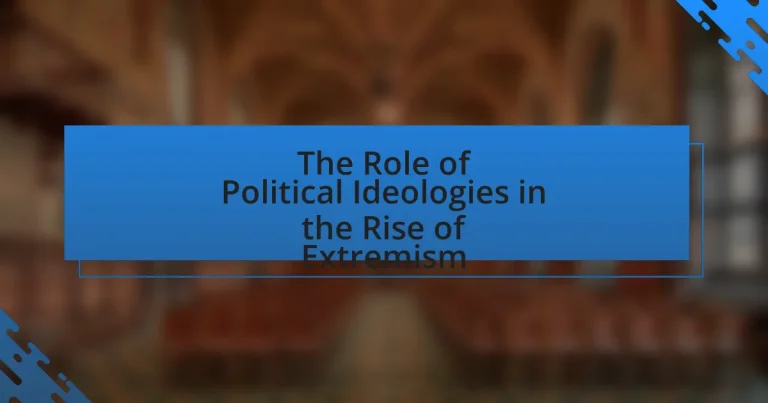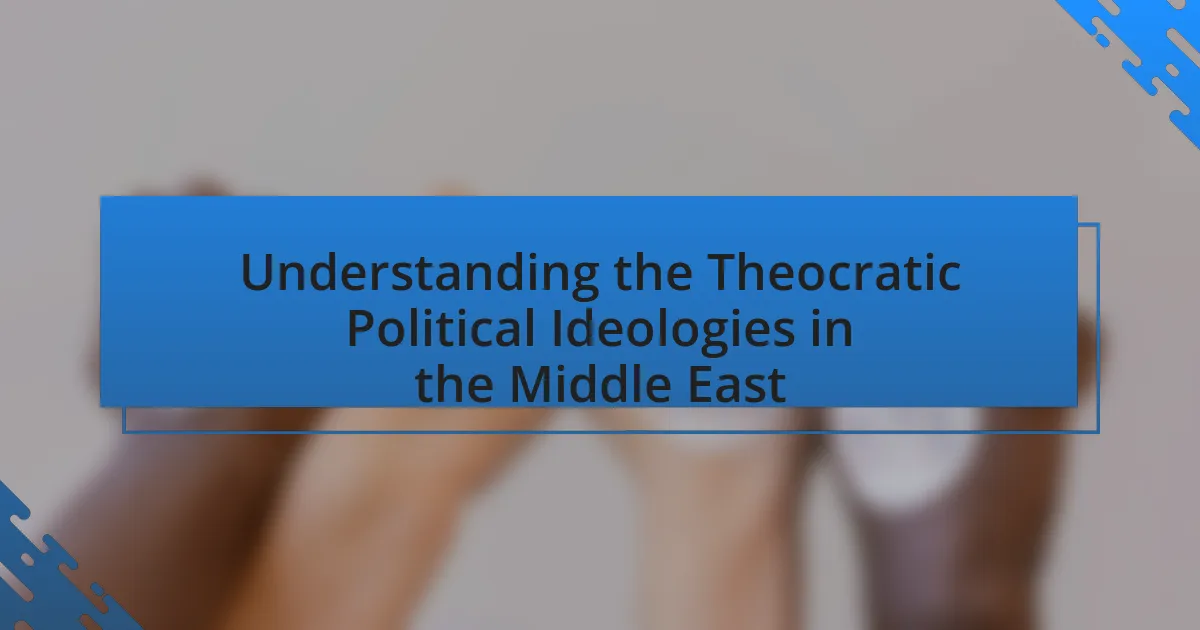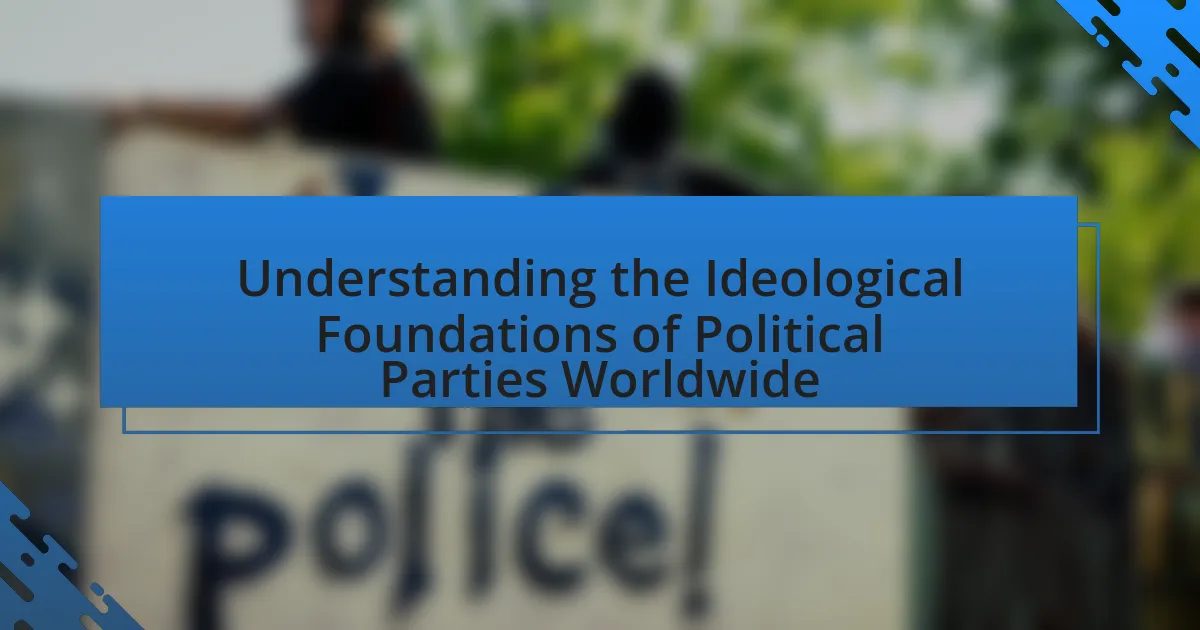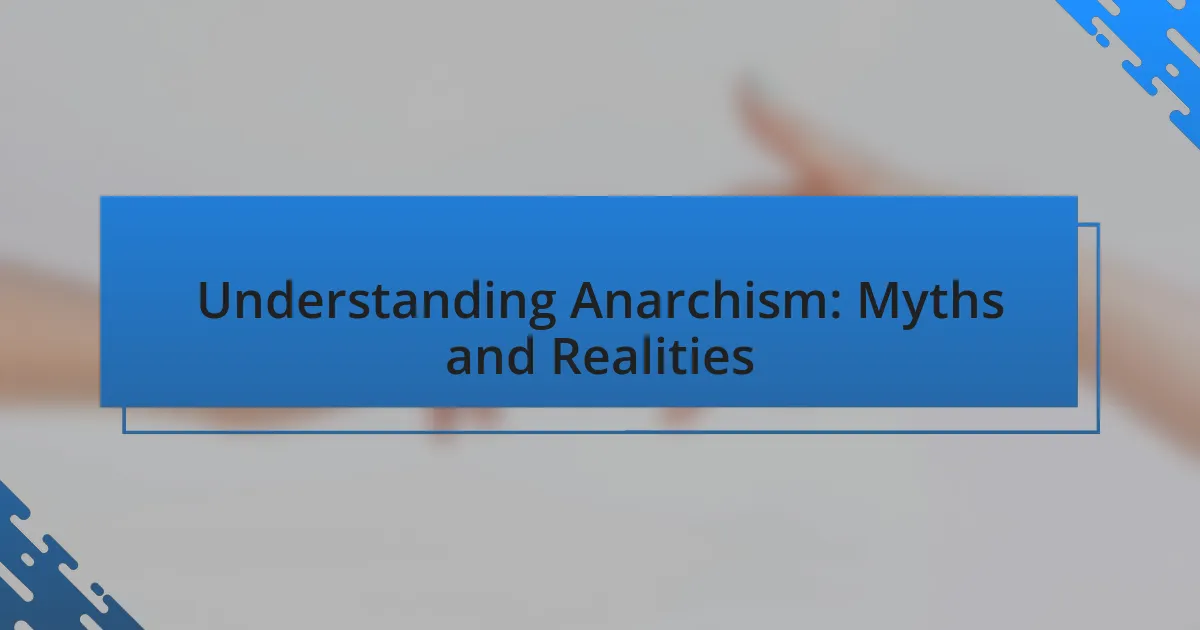The article examines the significant role of political ideologies in the rise of extremism, highlighting how these ideologies provide frameworks that justify radical beliefs and actions. It discusses various ideologies associated with extremism, including radical nationalism, religious fundamentalism, and far-left socialism, and their impact on shaping extremist groups’ beliefs. The article also explores the historical contexts that have influenced the relationship between political ideologies and extremism, as well as contemporary implications, including the role of social media and economic factors. Additionally, it outlines strategies for countering extremist ideologies through education, community initiatives, and promoting inclusive narratives.
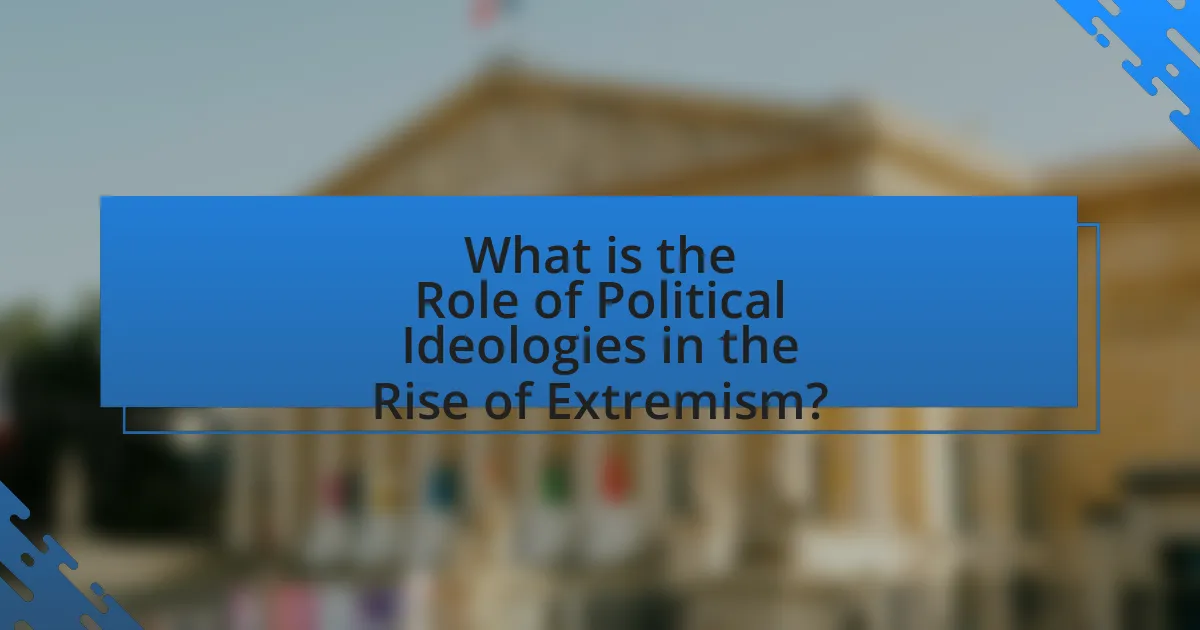
What is the Role of Political Ideologies in the Rise of Extremism?
Political ideologies play a significant role in the rise of extremism by providing a framework that justifies radical beliefs and actions. Extremist groups often adopt ideologies that emphasize division, superiority, and a perceived threat from others, which can mobilize individuals towards violent actions. For instance, the rise of jihadist extremism has been linked to a radical interpretation of Islam that frames Western influence as an existential threat, leading to violent responses. Similarly, far-right movements often draw on nationalist ideologies that promote xenophobia and racial superiority, as seen in the rise of groups like the Ku Klux Klan in the United States. Research indicates that individuals are more likely to engage in extremist behavior when they identify strongly with an ideology that legitimizes violence as a means to achieve political or social goals.
How do political ideologies contribute to extremist movements?
Political ideologies contribute to extremist movements by providing a framework that justifies radical beliefs and actions. These ideologies often emphasize a perceived moral superiority, creating an “us versus them” mentality that fosters division and hostility towards out-groups. For instance, ideologies such as radical nationalism or religious fundamentalism can lead adherents to view violence as a legitimate means to achieve their goals, as seen in groups like ISIS or far-right extremist organizations. Historical evidence shows that during times of social upheaval, such as the rise of fascism in Europe, extremist movements gained traction by exploiting economic instability and societal fears, further illustrating how political ideologies can catalyze radicalization.
What are the key political ideologies associated with extremism?
Key political ideologies associated with extremism include radical nationalism, religious fundamentalism, and far-left socialism. Radical nationalism often promotes the idea of ethnic superiority and can lead to xenophobia and violence against perceived outsiders. Religious fundamentalism, particularly in the context of Islamism or Christian extremism, seeks to impose strict interpretations of religious texts on society, often resulting in violent actions against those who do not conform. Far-left socialism, while advocating for social equality, can sometimes manifest in extremist actions against capitalist structures, leading to violent uprisings. Historical examples include the rise of Nazi Germany under radical nationalism, the actions of Al-Qaeda under religious fundamentalism, and the violent revolutions associated with far-left ideologies in various countries.
How do these ideologies shape the beliefs of extremist groups?
Ideologies shape the beliefs of extremist groups by providing a framework that justifies their actions and goals. For instance, ideologies such as radical nationalism or religious fundamentalism create a narrative that frames their worldview as superior and often portrays others as threats. This is evident in groups like ISIS, which uses a strict interpretation of Islam to legitimize violence and recruit followers, emphasizing a perceived moral obligation to defend their faith. Additionally, extremist ideologies often exploit social grievances, such as economic inequality or political disenfranchisement, to galvanize support and foster a sense of identity among members. This manipulation of ideology is supported by research indicating that individuals are more likely to adopt extremist beliefs when they feel marginalized or threatened, as seen in studies conducted by the Institute for Strategic Dialogue.
Why is understanding political ideologies crucial in addressing extremism?
Understanding political ideologies is crucial in addressing extremism because these ideologies often provide the framework for the beliefs and motivations that drive extremist behavior. Political ideologies shape individuals’ worldviews, influencing their perceptions of social justice, identity, and power dynamics. For instance, research indicates that extremist groups frequently exploit ideological narratives to recruit and radicalize individuals, as seen in the rise of groups like ISIS, which utilized a distorted interpretation of Islamic ideology to justify violence. By comprehensively understanding these ideologies, policymakers and practitioners can develop targeted interventions that counteract extremist narratives and promote more inclusive and peaceful alternatives.
What impact do political ideologies have on public perception of extremism?
Political ideologies significantly shape public perception of extremism by framing how individuals interpret and respond to radical beliefs and actions. For instance, individuals with left-leaning ideologies may perceive extremism primarily in terms of right-wing movements, often viewing them as threats to social justice and equality, while right-leaning individuals may focus on left-wing extremism, associating it with chaos and disorder. Research indicates that these ideological lenses influence not only personal beliefs but also media narratives and political discourse, which can amplify or downplay the perceived severity of extremist actions based on the ideological alignment of the audience. A study by the Pew Research Center found that political affiliation strongly correlates with perceptions of extremism, highlighting that Democrats and Republicans often disagree on what constitutes extremist behavior and who is responsible for it.
How can political ideologies influence government responses to extremism?
Political ideologies significantly influence government responses to extremism by shaping the frameworks through which threats are perceived and addressed. For instance, left-leaning governments may prioritize social justice and community engagement, leading to preventive measures that focus on addressing underlying social grievances, as seen in countries like Norway after the 2011 attacks, where the response emphasized integration and dialogue. Conversely, right-leaning governments often adopt a more security-focused approach, emphasizing law enforcement and military action, as evidenced by the U.S. response to domestic extremism post-9/11, which led to increased surveillance and counter-terrorism measures. These ideological perspectives dictate not only the strategies employed but also the resources allocated to combat extremism, ultimately affecting the effectiveness and public perception of government actions.
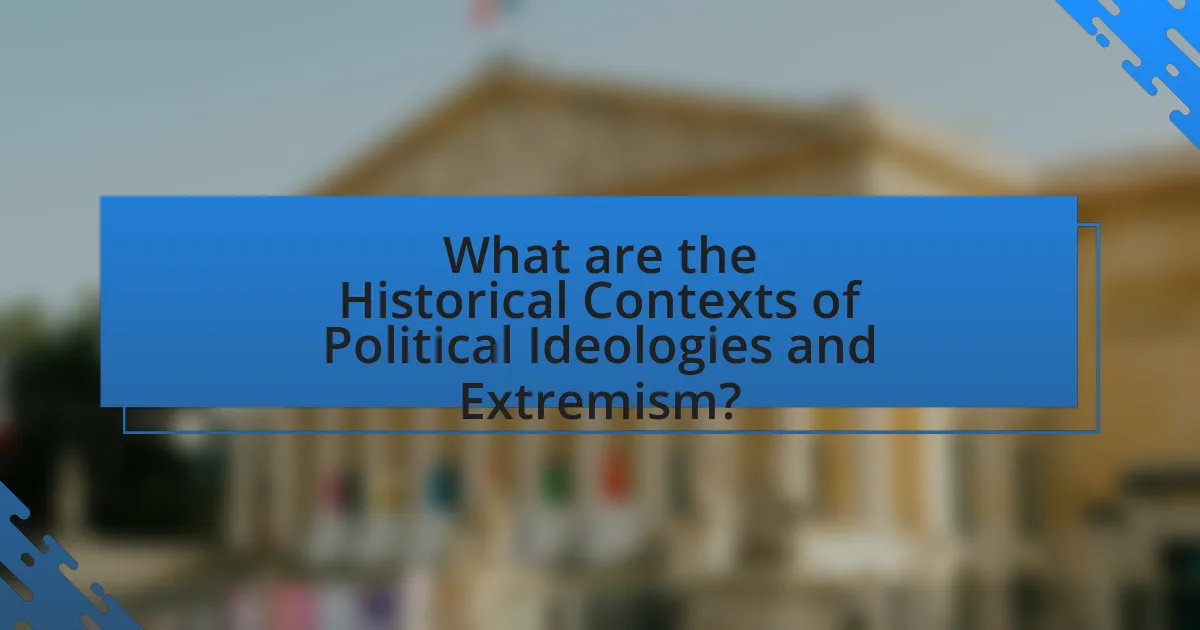
What are the Historical Contexts of Political Ideologies and Extremism?
The historical contexts of political ideologies and extremism are rooted in significant socio-political events and movements that shaped modern governance and societal structures. For instance, the rise of totalitarian regimes in the 20th century, such as Nazi Germany and Stalinist Soviet Union, exemplifies how extreme ideologies can emerge from economic turmoil and social unrest, leading to widespread violence and oppression. The aftermath of World War I and the Treaty of Versailles created fertile ground for extremist ideologies by fostering national humiliation and economic hardship in Germany, which facilitated the rise of Adolf Hitler and the Nazi Party. Similarly, the Russian Revolution of 1917, driven by Marxist ideology, resulted in the establishment of a communist state that suppressed dissent and promoted extreme measures against perceived enemies. These historical instances illustrate how political ideologies can evolve into extremism when they resonate with the public’s grievances and aspirations, often leading to radical actions and societal upheaval.
How have historical events shaped the relationship between political ideologies and extremism?
Historical events have significantly shaped the relationship between political ideologies and extremism by creating contexts in which radical beliefs gain traction. For instance, the aftermath of World War I led to the rise of fascism in Europe, as economic instability and national humiliation fostered extremist ideologies that promised national rejuvenation. Similarly, the Cold War era saw the emergence of various extremist movements, such as Maoism and radical Islamism, as political ideologies were often framed in opposition to perceived threats from rival powers, leading to violent extremism as a means of ideological expression. The September 11 attacks in 2001 further exemplified how geopolitical events can catalyze extremist ideologies, as they prompted a global response that fueled anti-Western sentiments and radicalization in various regions. These historical contexts illustrate how political ideologies can morph into extremism when societal conditions, such as economic distress or political oppression, create fertile ground for radical beliefs to flourish.
What role did the Cold War play in the rise of extremist ideologies?
The Cold War significantly contributed to the rise of extremist ideologies by creating a polarized global environment where ideological battles between capitalism and communism intensified. This ideological conflict led to the proliferation of radical movements as various groups sought to align themselves with or against these dominant ideologies. For instance, the U.S. and the Soviet Union supported proxy wars and regimes that often embraced extremist ideologies, such as Marxism-Leninism in various countries and anti-communist authoritarianism in others. The competition for influence resulted in the radicalization of political factions, as seen in regions like the Middle East and Latin America, where local grievances were exploited by extremist groups to gain support. Additionally, the fear of communism fueled anti-communist sentiments, leading to the rise of right-wing extremism in several nations, further entrenching divisions and fostering environments conducive to radical ideologies.
How have past political movements influenced contemporary extremist groups?
Past political movements have significantly influenced contemporary extremist groups by providing ideological frameworks and recruitment strategies. For instance, the rise of fascism in the early 20th century has inspired modern far-right groups, which adopt similar nationalist and anti-immigrant rhetoric. Historical events, such as the civil rights movement, have also shaped extremist responses, leading to the emergence of groups that oppose social progress and advocate for racial supremacy. The use of propaganda techniques from past movements, such as the Bolshevik Revolution’s mobilization strategies, is evident in how contemporary extremist groups utilize social media to spread their ideologies and recruit members. These connections illustrate how the legacy of past political movements continues to inform the tactics and beliefs of today’s extremist organizations.
What lessons can be learned from historical cases of extremism?
Historical cases of extremism reveal that political ideologies can significantly influence radicalization and violence. For instance, the rise of Nazi Germany illustrates how extreme nationalism and anti-Semitism, fueled by propaganda, led to widespread persecution and genocide. Similarly, the Khmer Rouge in Cambodia demonstrated that Marxist-Leninist ideology, when taken to extremes, resulted in the deaths of approximately 1.7 million people through forced labor and execution. These examples underscore the importance of recognizing and addressing the underlying ideologies that can foster extremism, as well as the need for early intervention and education to counteract radical narratives.
Which historical examples illustrate the dangers of political ideologies?
Historical examples that illustrate the dangers of political ideologies include the rise of Nazism in Germany and Stalinism in the Soviet Union. Nazism, driven by extreme nationalism and racial superiority, led to the Holocaust, resulting in the systematic murder of six million Jews and millions of others deemed undesirable. Stalinism, characterized by totalitarianism and state control, resulted in the Great Purge, where millions were executed or sent to labor camps, reflecting the dangers of oppressive political ideologies that prioritize ideology over human rights. These examples demonstrate how political ideologies can lead to extreme violence and human suffering when taken to their logical extremes.
How can historical analysis inform current strategies against extremism?
Historical analysis can inform current strategies against extremism by identifying patterns and root causes of extremist ideologies. For instance, examining the rise of fascism in the early 20th century reveals how economic instability and political disenfranchisement can fuel radicalization. This historical context allows policymakers to recognize similar conditions today, such as economic inequality and social alienation, which may lead to the resurgence of extremist movements. Furthermore, studies like the “Global Terrorism Index” highlight that understanding past terrorist groups’ motivations and tactics can guide contemporary counter-extremism efforts, enabling targeted interventions that address the specific grievances that drive individuals toward radical ideologies.
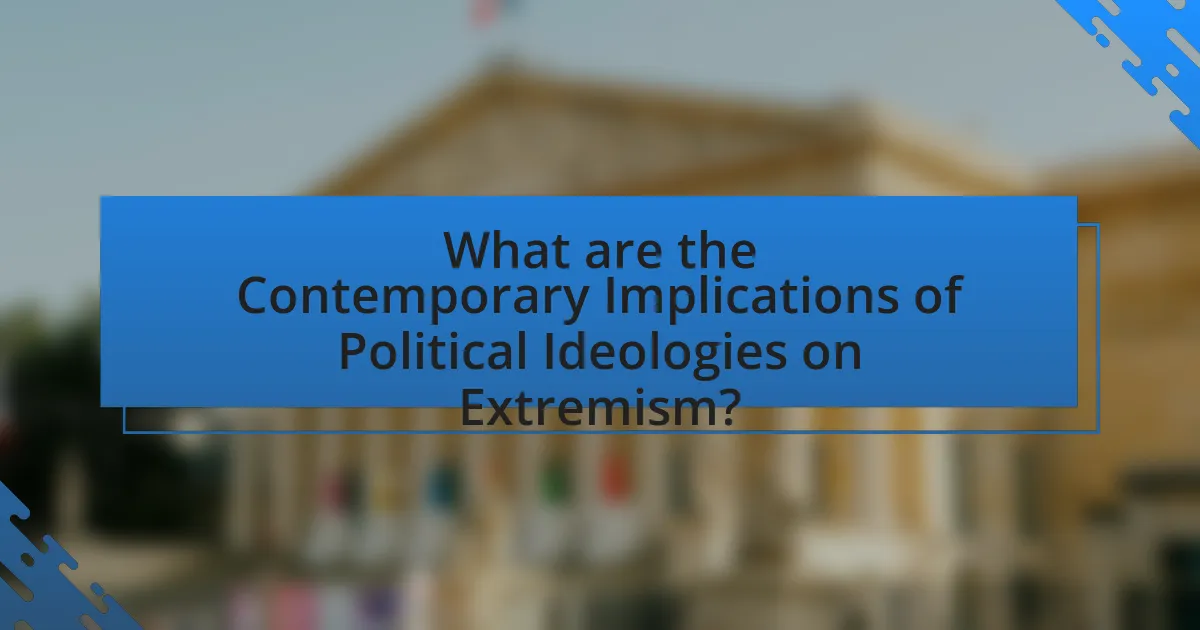
What are the Contemporary Implications of Political Ideologies on Extremism?
Contemporary political ideologies significantly influence extremism by shaping narratives that justify radical actions and mobilize individuals. For instance, far-right ideologies often promote xenophobia and nationalism, leading to increased hate crimes and violent acts against marginalized groups, as evidenced by the rise in incidents following the dissemination of extremist propaganda online. Similarly, left-wing ideologies can also foster extremism when they advocate for revolutionary change through violent means, as seen in various global movements that have resorted to terrorism to achieve political goals. Research indicates that the polarization of political beliefs contributes to an environment where extremist ideologies thrive, with studies showing that individuals exposed to radical political rhetoric are more likely to endorse violent actions.
How do modern political ideologies fuel current extremist movements?
Modern political ideologies fuel current extremist movements by providing a framework that justifies radical beliefs and actions. For instance, ideologies such as nationalism and religious fundamentalism often promote an “us versus them” mentality, which can lead to the dehumanization of perceived enemies. This is evident in the rise of far-right movements in Europe, where nationalist ideologies have been linked to increased xenophobia and violence against immigrants, as seen in the 2011 Norway attacks by Anders Breivik, who cited nationalist ideology as his motivation. Additionally, leftist ideologies can also contribute to extremism, as seen in various anti-capitalist movements that advocate for violent revolution against perceived oppressive systems. The intertwining of these ideologies with social media amplifies their reach, allowing extremist narratives to spread rapidly and recruit followers, as demonstrated by the use of platforms like Telegram by various extremist groups.
What role does social media play in the spread of extremist ideologies?
Social media significantly facilitates the spread of extremist ideologies by providing platforms for rapid dissemination and engagement. These platforms enable individuals and groups to share propaganda, recruit followers, and create echo chambers that reinforce radical beliefs. Research indicates that extremist groups utilize social media to reach wider audiences, with studies showing that 90% of extremist content is shared on platforms like Facebook and Twitter. This accessibility allows for the normalization of extremist views, making them more palatable to potential recruits.
How do economic factors intersect with political ideologies to promote extremism?
Economic factors intersect with political ideologies to promote extremism by creating environments of inequality and disenfranchisement that extremist groups exploit. For instance, high unemployment rates and economic instability can lead individuals to seek radical solutions, aligning with ideologies that promise change or scapegoat certain groups. Research indicates that regions with significant economic distress, such as the Middle East during the Arab Spring, saw a rise in extremist movements, as individuals turned to ideologies that offered a sense of identity and purpose in response to their economic grievances. Furthermore, the Global Terrorism Index highlights that countries with low economic development often experience higher levels of political violence, demonstrating the correlation between economic hardship and the appeal of extremist ideologies.
What strategies can be employed to counteract the influence of extremist ideologies?
To counteract the influence of extremist ideologies, strategies such as promoting inclusive narratives, enhancing education, and fostering community engagement can be employed. Inclusive narratives challenge extremist views by emphasizing shared values and common goals, which can reduce polarization. Education plays a critical role in equipping individuals with critical thinking skills, enabling them to analyze and reject extremist propaganda; for instance, programs that teach media literacy have been shown to decrease susceptibility to radicalization. Community engagement initiatives, such as dialogue programs and interfaith activities, build trust and understanding among diverse groups, effectively undermining the appeal of extremist ideologies by creating social cohesion.
How can education play a role in mitigating extremist ideologies?
Education can play a crucial role in mitigating extremist ideologies by promoting critical thinking, tolerance, and understanding of diverse perspectives. By equipping individuals with the skills to analyze information critically, education helps them discern between factual content and propaganda, reducing susceptibility to extremist narratives. Studies, such as those conducted by the Institute for Strategic Dialogue, have shown that educational programs focused on social cohesion and intercultural dialogue can significantly decrease the appeal of extremist ideologies among youth. Furthermore, education fosters empathy and social responsibility, which are essential in countering divisive ideologies and promoting peaceful coexistence.
What community initiatives have proven effective in combating extremism?
Community initiatives that have proven effective in combating extremism include mentorship programs, community policing, and interfaith dialogues. Mentorship programs, such as those implemented in cities like London, have successfully connected at-risk youth with positive role models, reducing their likelihood of engaging in extremist activities. Community policing initiatives, which foster trust between law enforcement and local communities, have been shown to enhance cooperation in identifying and addressing extremist threats, as evidenced by programs in the Netherlands that led to a decrease in radicalization. Interfaith dialogues, such as those organized by the United Nations Alliance of Civilizations, promote understanding and tolerance among different religious groups, effectively countering narratives that fuel extremism. These initiatives demonstrate measurable impacts on community cohesion and the reduction of extremist ideologies.
What practical steps can individuals take to understand and address the role of political ideologies in extremism?
Individuals can take several practical steps to understand and address the role of political ideologies in extremism. First, they should engage in critical analysis of various political ideologies by studying their historical contexts and impacts on society, which can reveal how certain ideologies may foster extremist views. For instance, examining the rise of fascism in the early 20th century illustrates how nationalist ideologies can lead to radicalization.
Second, individuals can participate in community discussions and workshops that focus on the implications of political ideologies, promoting dialogue that encourages diverse perspectives and reduces polarization. Research indicates that open dialogue can mitigate extremist sentiments by fostering understanding and empathy among differing viewpoints.
Third, individuals should educate themselves about the psychological and social factors that contribute to radicalization, such as identity crises or social isolation, which can be addressed through community support programs. Studies show that social integration and support networks can significantly decrease the likelihood of individuals adopting extremist ideologies.
Lastly, individuals can advocate for policies that promote inclusivity and counteract hate speech, as these measures can help create an environment that discourages extremist ideologies from taking root. Evidence from various countries demonstrates that proactive measures against hate speech can lead to a decrease in extremist activities.
